Saturday, November 27, 2004
barbarous Æ 18mm, Salonina, ?, n/a
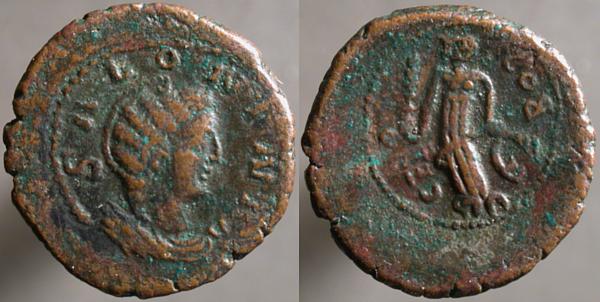
SALONINA A, Draped diademed bust right | (garbled), Female figure standing facing, head left, holding palm left.
An ancient imitative coin, roughly copying an issue in the name of Salonina, wife of Gallienus. The portrait of the empress is authentic-looking, and the obverse legend seems correct, but for running out of space before the end. The reverse legend is completely garbled, and the figure doesn't look like remind me of a specific legitimate coin that I can recognize.
The dies are both much smaller than the blank.
It doesn't seem likely that this was intended to fool anyone familiar with Roman imperial coins: it's too unlike them. On the other hand, that obverse is pretty fair evidence that the creator had at least one coin of Salonina in hand.
Warren Esty's extensive treatment of Ancient Imitations of Roman Coins can be found here.
Friday, November 26, 2004
Æ30, Side in Pamphylia, Gallienus, ...
SNG von Aulock 4849var (bust)
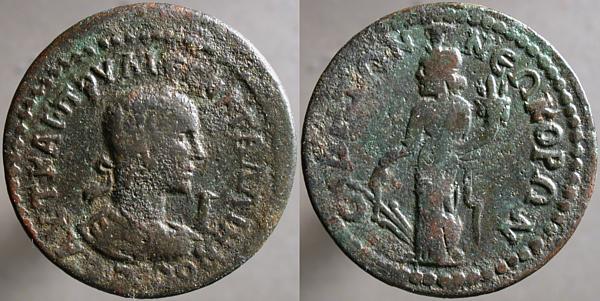
ΑΥΤ ΚΑΙ·ΠΟV ΛΙ ΕΓΝ ΓΑΛΛΙΗΝΟC CΕ, Laureate draped cuirassed bust right, I before | CΙΔΗΤΩΝ ΝΕΩΚΟΡΩΝ, Tyche standing facing, head left, holding cornucopia right and rudder left.
The closest match I can find to this is SNG von Aulock 4849, which has a radiate bust, not the laureate bust seen here. The reverse type is yet another Tyche. How exciting could that be, a 1,750-year-old coin, not quite in the usual catalogs, with a common reverse type? I recognize how wrong it is, but I really am just a bit bored by some aspects of this example.
Must work on that.

ΑΥΤ ΚΑΙ·ΠΟV ΛΙ ΕΓΝ ΓΑΛΛΙΗΝΟC CΕ, Laureate draped cuirassed bust right, I before | CΙΔΗΤΩΝ ΝΕΩΚΟΡΩΝ, Tyche standing facing, head left, holding cornucopia right and rudder left.
The closest match I can find to this is SNG von Aulock 4849, which has a radiate bust, not the laureate bust seen here. The reverse type is yet another Tyche. How exciting could that be, a 1,750-year-old coin, not quite in the usual catalogs, with a common reverse type? I recognize how wrong it is, but I really am just a bit bored by some aspects of this example.
Must work on that.
Thursday, November 25, 2004
Billon antoninianus, Gallienus, Rome, Göbl 615w
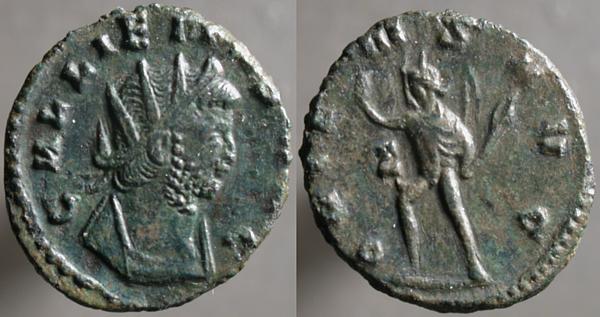
GALLIENVS AVG, Radiate cuirassed bust right | ORIENS AVG, Sol advancing left, raising hand left, cloak flying right. Z in left field.
Back in April, I posted a denarius with a similar reverse, associating Sol with the East. The Romans didn't have the compass, navigating largely by landmarks and, in the Mediterranean, by predictable winds.
But the sun was seen to rise in the East, then as now, and our word for finding one's location, orientation, still recognizes that essential fact.
Meanwhile, have a happy Thanksgiving.
Wednesday, November 24, 2004
AR denarius, Commodus, Rome, RIC 251
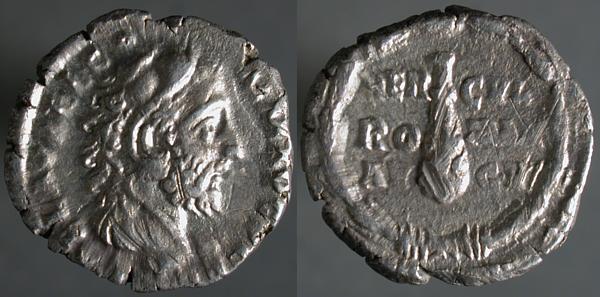
[L AEL] AVREL COMM [AVG P FEL], Head of Commodus, wearing lion skin as Hercules, right | HERCVL / ROMAN / AVG V , Legend in three lines across the club of Hercules, all within wreath.
That Marcus Aurelius Commodus Antoninus became emperor is the severest indictment of his father, Marcus Aurelius. Commodus is remembered as one who would have been better strangled at birth. (We hates him, we does.)
He renamed the months, the legions, the senate and the city of Rome (none of the renamings survived him by much.) He's shown here in the lion-skin traditional to Hercules, and is proclaimed on the reverse as the Roman Hercules. He seems to have done, and believed, that.
He died on the last day of 192, assassinated in his bath.
193 saw emperors come and go. Eventually Septimius Severus was able to take and hold the throne.
Tuesday, November 23, 2004
Æ29, Tyre in Phoenicia, Gallienus, BMC 489var...
(reverse legend)
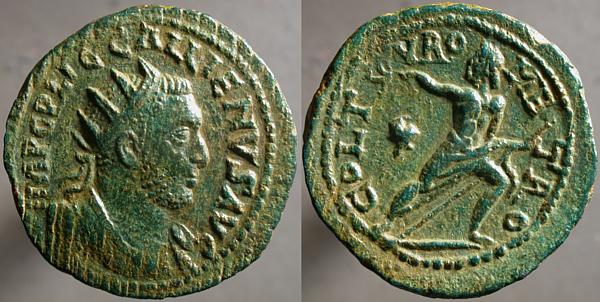
IMP C P LIC GALLIENVS AVG, Radiate cuirassed bust right | COL T_VRO ME_TRO, Kadmos(?) advancing right, looking back, beckoning with right hand, holding long staff in left; murex shell in left field.
A recent acquisition, the best-preserved Tyrian coin I have.
Kadmos, myth says, was grandson of Apollo, son of the king of Phoenicia, and brother of Europa. After a long, fruitless, search for his sister he founded Thebes, in Boeotia. He's not a common subject for coins but, when seen, they're more often seen from Phoenicia than from Boeotia.

IMP C P LIC GALLIENVS AVG, Radiate cuirassed bust right | COL T_VRO ME_TRO, Kadmos(?) advancing right, looking back, beckoning with right hand, holding long staff in left; murex shell in left field.
A recent acquisition, the best-preserved Tyrian coin I have.
Kadmos, myth says, was grandson of Apollo, son of the king of Phoenicia, and brother of Europa. After a long, fruitless, search for his sister he founded Thebes, in Boeotia. He's not a common subject for coins but, when seen, they're more often seen from Phoenicia than from Boeotia.
Monday, November 22, 2004
Strengthen the good
The C.S. Lewis Bilingual Gymnaziumin in Bratislava, Slovakia.
Billon antoninianus, Gallienus, Rome, Göbl 146v
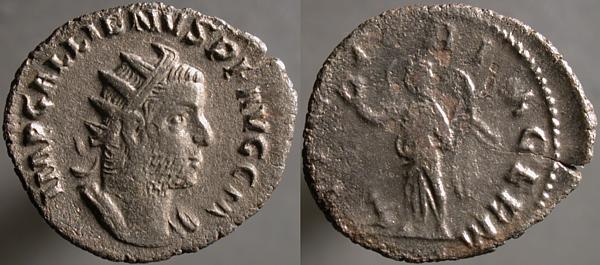
IMP GALLIENVS P F AVG G M, Radiate cuirassed bust right | VICTORIA GERM, Victoria advancing left, palm over shoulder, holding wreath left. Captive at feet left.
This coin is part of a series, issued late in the joint reign of Valerian and Gallienus, in which Gallienus is given titles relating to his victories, realized and hoped-for, over the German tribes. On this, the reverse also celebrates those victories.
Sunday, November 21, 2004
Æ tetradrachm, Alexandria, Gallienus, 265-266 CE, Emmett 3810(13)

ΑΥΤ Κ Π ΛΙΚ ΓΑΛΛΙΗΝΟC CΕΒ, Laureate draped bust right | LΙΓ, Eirene standing facing, head left, holding branch left and transverse scepter. Palm in right field. Regnal year in left field.
Back in July I posted a coin of Valerian, from 255-256, with a reverse showing Eirene, the goddess of peace. Today's coin was minted ten years later, for Gallienus.

